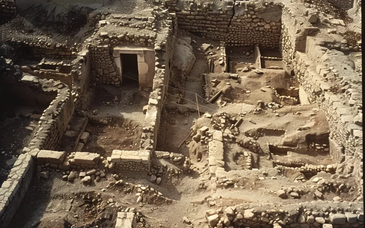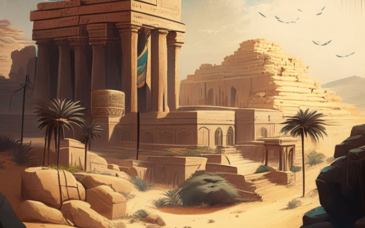Three of the largest religious faiths all see this small piece of earth as holy ground. The combination of the importance of this space to Christians, Jews and Muslims makes this piece of rock unquestionably the holiest place on earth. Located atop the Temple Mount in Jerusalem, the Islamic Shrine encloses a large rock approximately 2,400 square feet in size. The rock is known as the Foundation Stone and is intertwined in the history of all three religions. The Dome of The Rock is a magnificent piece of architecture and is one of the most recognizable landmarks in the world. Just what makes this small piece of rock so important? Why do so many make pilgrimages to the see it? Do the three major religions share the same beliefs concerning the Foundation Stone? To properly answer all of these questions could take several books, so this article will only scratch the surface of the subject, but will hopefully give you a good overview of why this rock is indeed, the Holiest Place On Earth.

The portion of the rock which is visible to visitors is approximately 43 feet by 56 feet (13.1 meters by 17.0 meters) in size. It is the highest natural point on the Temple Mount and was enclosed within the Dome of the Rock in 638 A.D. Jews and Christians believe the Foundation Stone was once contained in Solomon's Temple as well as the temple constructed by King Herod. The Stone would have been located within the Holy of Holies inside the temple. During the time of Solomon the Ark of the Covenant would have sat atop the Foundation Stone. By the time of King Herod the Ark had disappeared and was lost to history, its location a mystery with several suspected locations, but none confirmed. The Foundation Stone, according to some, is introduced very early in the Bible narrative.
The Book of Jubilees is basically a alternative version of the book of Genesis. The Book of Jubilees is believed to have been written in the second century B.C. and covers from the creation of the universe to the time of Moses. The parallels between the two books are amazing, agreeing on many of the major events. The book is broken down into Jubilees, each of which covers 49 years. The Book of Jubilees offers considerably more details than does the Biblical Book of Genesis. These differences include the names of Noah's daughters, and in relation to our current subject, the location of the Garden of Eden. The Foundation Stone, it is believed, was located at the center of the Garden of Eden. Moreover, the stone is also believed to mark the burial site of Adam and Eve, the best known residents of the garden. The Book of Jubilee is not included in the Bible for a number of reasons, the most significant being that we are uncertain if the book we currently have only fragments of matches the original book. Regardless of the book of Jubilee's authenticity, the stone's place in tradition and biblical history goes well beyond the Garden of Eden.
One of the most significant points in the history of the Foundation Stone for all three faiths comes from the story of Abraham. Considered the father of three faiths, Abraham is a major figure in the biblical story of God's interaction with man. In Genesis, chapter 22, Abraham is instructed to sacrifice his only son, Isaac. The Muslim version of this story replaces Isaac with Ishmael and is a major separation point for the two religions.
Then God said, “Take your son, your only son, whom you love—Isaac—and go to the region of Moriah. Sacrifice him there as a burnt offering on a mountain I will show you.”
3 Early the next morning Abraham got up and loaded his donkey. He took with him two of his servants and his son Isaac. When he had cut enough wood for the burnt offering, he set out for the place God had told him about. 4 On the third day Abraham looked up and saw the place in the distance. 5 He said to his servants, “Stay here with the donkey while I and the boy go over there. We will worship and then we will come back to you.”
6 Abraham took the wood for the burnt offering and placed it on his son Isaac, and he himself carried the fire and the knife. As the two of them went on together, 7 Isaac spoke up and said to his father Abraham, “Father?”
“Yes, my son?” Abraham replied.
“The fire and wood are here,” Isaac said, “but where is the lamb for the burnt offering?”
8 Abraham answered, “God himself will provide the lamb for the burnt offering, my son.” And the two of them went on together.
9 When they reached the place God had told him about, Abraham built an altar there and arranged the wood on it. He bound his son Isaac and laid him on the altar, on top of the wood. 10 Then he reached out his hand and took the knife to slay his son. 11 But the angel of the Lord called out to him from heaven, “Abraham! Abraham!”
“Here I am,” he replied.
12 “Do not lay a hand on the boy,” he said. “Do not do anything to him. Now I know that you fear God, because you have not withheld from me your son, your only son.”
It is believed the mountain top on which Abraham built the altar was in fact the Foundation Stone. Not only was this the location of the Garden of Eden, where God first introduced Himself to man, but the place on which Abraham showed his unquestioned faith and trust in God. It would also eventually be the site on which Solomon would built a temple to house the Ark of the Covenant. It is easy to see why this spot holds such a significant place in both the Christian and Jewish faiths but the unilateral importance of this Holy Land does not stop there.
Before moving on to the a key reason the Foundation Stone is important to the Islamic faith, let us first look at another feature of interest concerning this Holy piece of land. The Dome of the Rock covers not only the Foundation Stone but the entrance to a cave located directly beneath the stone. This cave is quite large and some believe just one of many subterranean chambers on the Temple Mount. National Geographic reported there are at least 45 known cisterns, chambers, tunnels and caves on the Temple Mount. The cave is rarely open to visitors but it does offer an interesting possibility when it is available. Visitors can knock on the floor and create a clear echo sound, as if there is another chamber or cave below. Some believe this is the Well Of Souls where the Ark of the Covenant was hidden from time to time. The area has been closely examined by many experts and interestingly none have been able to confirm the existence of a second cave, but none have been able to disprove its existence either. If the cave is there it is highly unlikely the Ark is there, at least not in a form we would recognize. The Bible tells use the Ark was built of wood overlaid with gold. The wood in the box would have likely disintegrate in the cool damp environment of the cave. It is much more likely the Ark, if it survived the many attacks upon Jerusalem, would have been stored in a much more protective climate.
The Islamic faith holds that the prophet Muhammad ascended to heaven on his nights journey. Tradition holds that Muhammad began his ascent from atop the Foundation Stone. When Muhammad ascended into heaven the Foundation Stone began to rise with him. The angel Gabriel had to hold the rock in place to keep it on earth. There are several markings on the Foundation Stone which Islamic tradition holds are the marks left by Gabriel when he held down the stone. Some versions of the story say Muhammad was riding on Al-Buraq when he ascended from the rock. Most scholars believe this portion of the tradition was created at a later date as the first mention of it is several hundred years after the construction of the Dome of the Rock. Regardless, this piece of land holds a very significant place in Islamic history and is considered Holy by most if not all of the Islamic faithful.
At roughly the size of an average house, the Foundation Stone is front and center in many of the pivotal events in the history of Jews, Christians and Muslims spiritual journeys. The stone has also been referred to as "Omphlos Mundi". An omphalos is a religious stone or stone artifact. In Greek omphalos means navel. The Foundation Stone, the navel of the world, the center point of the earth. Jewish tradition tells us the Foundation Stone is the junction place between Heaven and Earth. Islamic beliefs say the angel Israfel will stand on the Foundation Stone to sound the trumpet on Resurrection Day. Jews all over the world pray facing the Foundation Stone. Islamist at one point also faced the Foundation Stone when praying but later changed to face Mecca. Many believe the Dome of the Rock is a mosque but it is actually a shrine and is the oldest Islamic monument still standing. There are many carvings paintings and inscription decorating the inside of the Dome of the Rock. A good portion of the inscriptions on one section of the octagonal arcade encourages Christians to depart from the error of the Holy Trinity and recognize the truth of Islam. Jews and Christians believe a third temple will one day be built on the Temple Mount which will bring about the Divine Presence and the healing of all mankind. So not only does the Foundation Stone hold a very significant place in the history of all three religions, it also holds a special place in their visions for the future.
Archaeological excavations continue around the Temple Mount and fascinating discoveries continue to be made. These excavations often stir debate and controversy within an area struggling with political and religious tensions. Debate continues over who should control this section of earth, and even who has a historical right to the land. There are few easy answers, and the debate will not likely be resolved in the near future. The Foundation Stone, the Holiest Place on Earth, continues to hold the interest of millions, give hope to people of faith, and stand as a spotlight on our past, and a beacon to our future.




